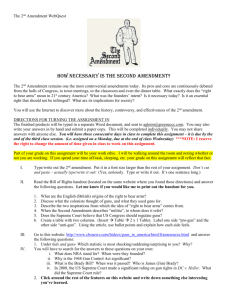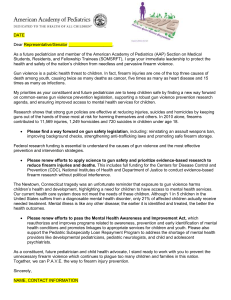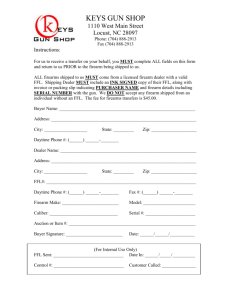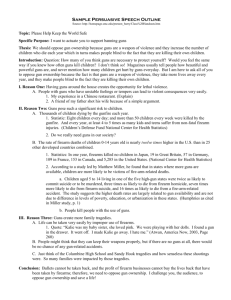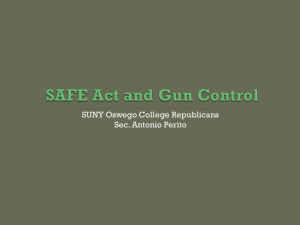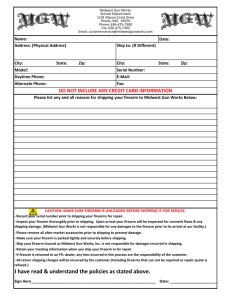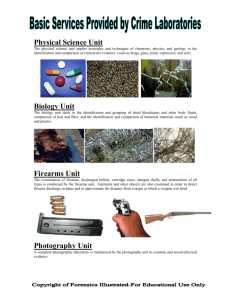Problem-Cause-Solution Format
advertisement
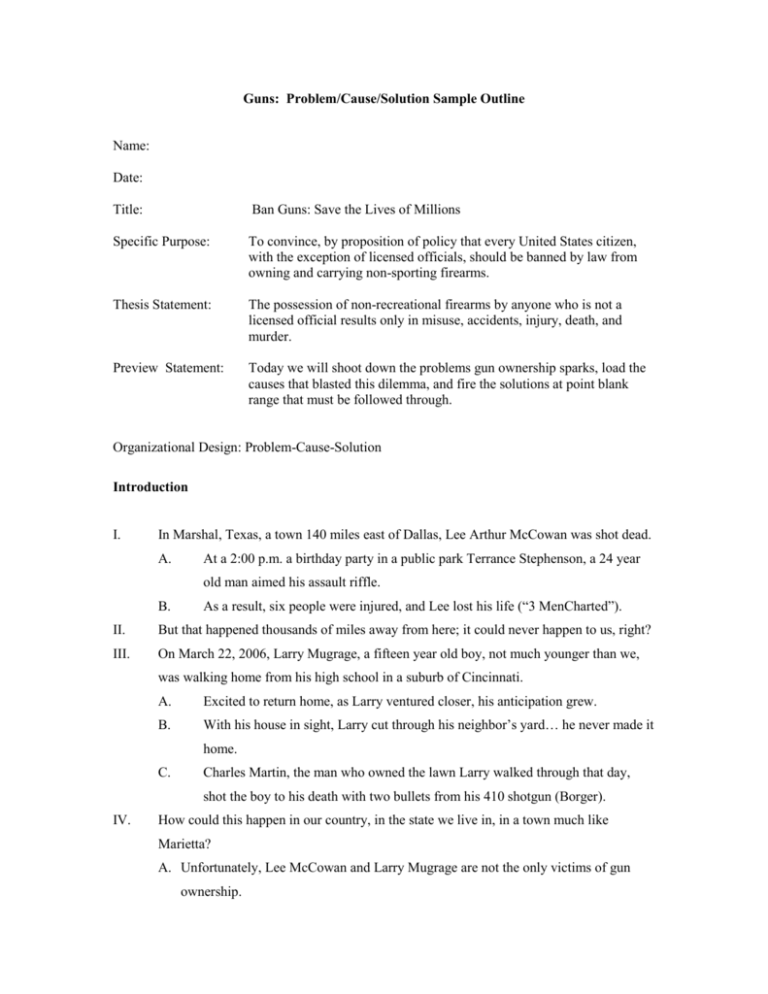
Guns: Problem/Cause/Solution Sample Outline Name: Date: Title: Ban Guns: Save the Lives of Millions Specific Purpose: To convince, by proposition of policy that every United States citizen, with the exception of licensed officials, should be banned by law from owning and carrying non-sporting firearms. Thesis Statement: The possession of non-recreational firearms by anyone who is not a licensed official results only in misuse, accidents, injury, death, and murder. Preview Statement: Today we will shoot down the problems gun ownership sparks, load the causes that blasted this dilemma, and fire the solutions at point blank range that must be followed through. Organizational Design: Problem-Cause-Solution Introduction I. In Marshal, Texas, a town 140 miles east of Dallas, Lee Arthur McCowan was shot dead. A. At a 2:00 p.m. a birthday party in a public park Terrance Stephenson, a 24 year old man aimed his assault riffle. B. As a result, six people were injured, and Lee lost his life (“3 MenCharted”). II. But that happened thousands of miles away from here; it could never happen to us, right? III. On March 22, 2006, Larry Mugrage, a fifteen year old boy, not much younger than we, was walking home from his high school in a suburb of Cincinnati. A. Excited to return home, as Larry ventured closer, his anticipation grew. B. With his house in sight, Larry cut through his neighbor’s yard… he never made it home. C. Charles Martin, the man who owned the lawn Larry walked through that day, shot the boy to his death with two bullets from his 410 shotgun (Borger). IV. How could this happen in our country, in the state we live in, in a town much like Marietta? A. Unfortunately, Lee McCowan and Larry Mugrage are not the only victims of gun ownership. 2 B. The National Center for Injury Prevention and Control reports that in 2003, 30,136 people died in our country as a result of guns. 1. That is more than one percent of the population which means one of every one hundred people lost their life to a firearm. 2. That would be four people from our freshman class here at Marietta. V. Today we will shoot down the problems gun ownership sparks, load the causes that blasted this dilemma, and fire the solutions at point blank range that must be followed. Transition: Let’s begin by taking aim at the problem. Body I. The problem with people owning guns who do not need them for their profession and are not properly trained to use them is that these guns kill people. A. The fatality rate of firearm violence is similar to HIV, which is recognized as an epidemic by the Centers for Disease Control and Prevention (Firearm Injury”). 1. Guns are the second leading cause of death from injury in United States only after motor vehicle crashes (“Firearm Injury”). 2. Firearms are involved in approximately 70% of homicides, 60% of suicides, 40% of robberies, and 20% of aggravated assaults (“Firearm Injury”). B. Furthermore, 40% of homes in the United States own guns. 1. Half of the people in this room grew up with at least one firearm in their household; some had so many that they couldn’t even relate the exact number (Student Questionnaire). 2. Those guns are 22 times more likely to be involved in an accidental shooting and 11 times more likely to be used for suicide than for self defense (Borger). 3. It is not surprising, then, that the United States has both the highest number of privately owned guns among industrialized nations and the highest rate of firearm homicides (“Firearm Injury”). C. What most of us don’t realize is that these weapons are killing the children in our country as well. 3 1. Tamarla Owens nearly went into shock when her six year old son ran to her saying, “Mamma, I shot a little girl, I didn’t mean to, I’m sorry” (Adams). a. This first grader at Buell Elementary School outside Flint, Michigan, killed his classmate, Kayla Rolland, on February 29, 2000. b. The six year old found a .32 caliber semiautomatic pistol in a shoebox in his uncle’s bedroom. c. He took it to school the next day and thus the life of an unsuspecting little girl. 2. Nearly 1000 children under the age of 19 are murdered every year by guns, 800 use them to commit suicide, and more than 160 are killed in accidents involving firearms (Borger). 3. Twelve children in the United States die of gun shot wounds every day (“US Moms Protest”). Transition: Now that we’ve targeted the problem, let’s load the causes behind it. II. The cause of our problem can be traced to two major sources: current laws and the lack of responsibility of gun owners. A. It seems that the more laws that are passed regarding firearms, the easier it is for Americans to misuse them. 1. Under current law, no single government agency has administrative authority to monitor firearm safety and federal funds are strictly limited to how they can be used for firearm injury prevention (Firearm Injury Center). a. There are no uniform laws throughout the states that regulate the ownership and sale of firearms (Bill 347). b. Additionally, Guns remain one of the few consumer products exempt from regulation by the Consumer Product Safety Commission, even though, unlike many other lethal objects, the only purpose of a gun is to kill or wound (Adams). 4 2. On November 30, 1993, Bill Clinton signed the Brady Handgun Violence Protection Act which required a background check for gun purchases from retail dealers (Adams). a. A year later, he signed legislation banning the production of military-style assault weapons. b. In 1994, a national ban was placed on assault weapons; on September 13, 2004, President Bush allowed it to expire. 3. In December of 2000, less than a year after Kayla, the first grader in Michigan, was killed, lawmakers made it legal to carry a concealed weapon (Adams). 4. Michael R. Bloomberg, the mayor of New York City is currently fighting illegal guns in the United States on Capitol Hill (Chan). B. The confusing, inconsistent, sometimes outright dangerous laws aren’t the only source of the problem, though; the irresponsibility of gun owners adds to the cause. 1. What was a gun doing in a shoe box for a six year old to find at his uncle’s house? a. A majority of you agree that availability is a serious cause of gun violence (Student Questionnaire). b. Gun owners are not making wise decisions concerning where they keep their firearms and ammunition. 2. Additionally, the people who are buying and using guns are not properly trained. a. There are classes in proper firearm technique that can easily be taken by anyone interested (Bill 460). b. Furthermore, even classes in firearm safety are offered in most major cities. Transition: We have blown away the problem and causes; now, let’s shoot down some solutions. III. Luckily for our lives and the lives of our children, there is a solution—the only way to eliminate death caused by firearms is to eliminate firearms; until that state is reached and in order to reach that goal we must take action on a personal, state, and national level. A. Let’s begin with what we can do on a personal level until the law is passed. 5 1. If you ever own a gun, make sure you know how to use it. a. Take firearm training courses. b. Take firearm safety courses. 2. If there is a gun in your home, make sure it is stored where a child can not access it; make sure it is always unloaded; and never keep the ammunition in the same location as the gun. 3. If someone you know owns a gun, make sure he or she does the same. B. The next level upon which each one of us can take action is the state level. 1. Contact your state representative (Jennifer Garrison is currently representing our district in the state legislature), and express your opinions about gun ownership. 2. Do not allow the legislators to pass any more laws allowing just anyone to carry a concealed weapon. 3. And force them to take action to pass stricter laws regulating gun control that will eventually lead to a ban on possession. C. Above these efforts, we can all make an impact to save lives on the national level. 1. Mayor Bloomberg is just one man, and he’s fighting for change (Chan). 2. We can write letters to members of our Congress urging them to consider our safety, their safety, and the safety of the 2000 children who shouldn’t have to die next year by a gun’s bullet (Borger). Conclusion I. Today we shot down the problems gun ownership sparks, loaded the causes that blasted this dilemma, and fired the solutions at point blank range. A. For the stories of Lee Arthur McCowan, Larry Mugrage, Kayla Rolland, and the other millions of Americans who have lost their lives to a firearm there is no happy ending. 1. There is no twist or surprise to reveal about their stories. 2. They are all dead. 3. But none of them deserved to die. B. Steve Lenkart, chief lobbyist for the International Brotherhood of Police Officers made the statement after military-style weapons were once again allowed on the streets in 2004, “people are going to die; cops are going to die; civilians are going to 6 die; I don’t think it will be Armageddon, but I think there will be a flood of weapons” (Adams). C. So take action. 1. This time it was a man in Texas, a boy from Cincinnati, and a first grader from Michigan, but whom will violence’s next victim be? a. Perhaps she will live a bit closer; you might know her. b. Maybe he’ll be from your hometown. c. Maybe she’ll be from this college… or this class. 2. There’s only one way to assure that it isn’t you. II. Change the world, and save the lives of millions. 7 Works Cited “2003, United States Firearm Deaths and Rates per 100,000.” WISQARS Injury Mortality Report. National Center for Injury Prevention and Control. CDC. Dawes Mem. Lib. 26 Mar. 2006. <http://webapp.cdc.gov>. “3 Men Charged in Fatal Texas Park Shooting.” The New York Times 2 Apr. 2006. 2 Apr. 2006. <http://nytimes.com>. Adams, Bob. "Gun Control Debate." The CQ Researcher 14.40 (2004). 26 Feb. 2006 <http://library.cqpress.com/>. Bill 347. Ohio General Assembly. Legislative Service Commission. CQ Weekly 62.47 (2004). Dawes Mem. Lib. 26 Feb. 2006 <http://library.cqpress.com/>. Bill 460. Ohio General Assembly. Legislative Service Commission. CQ Weekly 62.47 (2004). Dawes Mem. Lib. 26 Feb. 2006 <http://library.cqpress.com/>. Borger, Julian. “Trespassing Teen Shot as Law of the Gun Still Rules.” The Age 23 Mar. 2006. Copyright 2006. The Age Company 26 Mar. 2006. <http://www.theage.com.au>. Chan, Sewell. “In His War on Illegal Guns, Bloomberg Is Facing Uphill.” The New York Times 2 Apr. 2006. 2 Apr. 2006. <http://nytimes.com>. Firearm Injury Center at Penn. “Firearm Injury in the U.S.” Resource Book. 2 Apr. 2006. <http://www.uphs.upenn.edu>. Honors 202 Questionnaire. Marietta College. 21 Mar. 2006. Marietta, OH. “US Moms Protest Against Guns.” BBC News. 15 May 2000. 26 Mar. 2006. <http://news.billinge.com>.

